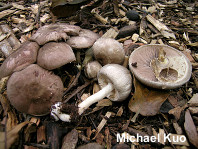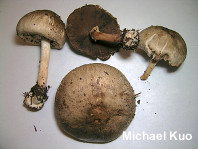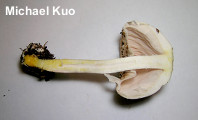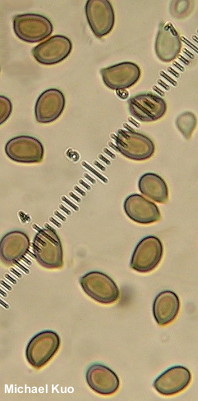| Major Groups > Gilled Mushrooms > Dark-Spored > Agaricus > Agaricus pocillator |

|
Agaricus pocillator [ Basidiomycota > Agaricales > Agaricaceae > Agaricus . . . ] by Michael Kuo "The cup at the base of the stem," wrote the mycologist who first named this species (Murrill 1941), "is quite remarkable and unexpected." Like many species of Agaricus, Agaricus pocillator features a bulbous stem base—but in this case the bulb's upper side appears to be scooped out, so that the bulb appears like a little cup holding the stem (enlarge the second illustration and view the left-hand specimen). Other distinguishing features include the relatively slender stature of the mushrooms, the brownish to brown cap with a dark center, and the phenolic odor (if your sniffer, unlike mine, can register this smell). Agaricus pocillator is a forest-dwelling species found in the southeastern United States, ranging into the southern Appalachians. It is similar to the larger, more robust Agaricus placomyces, and very similar to darker forms of Agaricus leptocaulis—but neither of these species features a cuplike stem base. Previous versions of this webpage actually featured Agaricus leptocaulis, which was named by Kerrigan in 2016. Additionally, my treatment of "Agaricus pocillator" in Mushrooms of the Midwest (2014) is actually a treatment of Agaricus leptocaulis. Based on analysis of the photo provided, Phillips (1991/2005) apparently does the same in Mushrooms and Other Fungi of North America. Description: Ecology: Saprobic; growing alone or gregariously under hardwoods and conifers in forests; summer and fall; southeastern United States, north to the southern Appalachians. The illustrated and described collection is from Georgia. Cap: 3–7 cm; convex at first, becoming broadly convex in age; dry; grayish brown overall, with appressed, innate, brown fibrils over a pale background; often with a darker center; the margin not yellowing when rubbed repeatedly. Gills: Free from the stem; close or crowded; short-gills frequent; white, becoming pink, then brown; when young covered by a whitish partial veil that may develop brown stains. Stem: 4–7 cm long; 0.5–1 cm thick; more or less equal above a small bulbous base; bulb usually cuplike, featuring a scooped-out upper side; whitish, bruising yellow; with a ring that typically persists into maturity. Flesh: White throughout; staining bright yellow in the base. Odor and Taste: Odor phenolic or not distinctive. Chemical Reactions: Liquid Drano yellow on cap (I was traveling and did not have KOH). Spore Print: Brown. Microscopic Features: Spores 5–6 x 3–3.5 µm; more or less ellipsoid; smooth; thick-walled; brown in KOH. Basidia 4-sterigmate. Cheilocystidia 15–25 x 5–8 µm; cylindric to subclavate; smooth; thin-walled; hyaline in KOH. Pileipellis a cutis; elements 2.5–5 µ wide, smooth or a little encrusted, yellow-brown in KOH. REFERENCES: Murrill, 1941. (Freeman, 1979; Weber & Smith, 1985; Kerrigan et al., 2005; Kerrigan, 2016; Woehrel & Light, 2017.) Herb. Kuo 10170901. This site contains no information about the edibility or toxicity of mushrooms. |
© MushroomExpert.Com |
|
Cite this page as: Kuo, M. (2018, January). Agaricus pocillator. Retrieved from the MushroomExpert.Com Web site: http://www.mushroomexpert.com/agaricus_pocillator.html |



